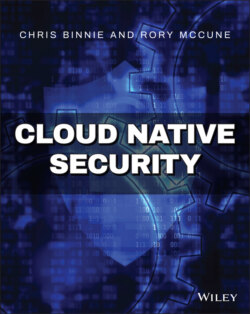Читать книгу Cloud Native Security - Chris Binnie - Страница 10
What Does This Book Cover?
ОглавлениеHere's a chapter-by-chapter summary of what you will learn in Cloud Native Security:
Chapter 1: What Is A Container? The first chapter in Part I discusses the components that comprise a Linux container. Using hands-on examples, the chapter offers the perspective of these components from a Linux system's point of view and discusses common types of containers in use today.
Chapter 2: Rootless Runtimes This chapter looks at the Holy Grail of running containers, doing so without using the root user. An in-depth examination of Docker's experimental rootless mode, followed by an in-depth look at Podman being run without using the superuser, helps demonstrate the key differences between the runtimes.
Chapter 3: Container Runtime Protection This chapter looks at a powerful open source tool that can provide impressive guardrails around containers. The custom policies can be used to monitor and enforce against unwanted anomalies in a container's behavior.
Chapter 4: Forensic Logging This chapter examines a built-in Linux Auditing System that can provide exceptional levels of detail. Using the auditing system, it is possible to walk, step-by-step, through logged events after an attack to fully understand how a compromise was successful. In addition, misconfigurations and performance issues can be identified with greater ease.
Chapter 5: Kubernetes Vulnerabilities This chapter looks at a clever tool that uses a number of detailed checks to suggest suitable security and compliance fixes to Kubernetes clusters. Such advice can be useful for auditing both at installation time and in an ongoing fashion.
Chapter 6: Container Image CVEs By using the best of three Common Vulnerability and Exploit scanning tools, or a combination of them, it is possible to capture a highly detailed picture of the vulnerabilities that require patching within static container images.
Chapter 7: Baseline Scanning (or, Zap Your Apps) This chapter is the first of Part II, “DevSecOps Tooling,” and explores the benefits of performing baseline tests within a CI/CD pipeline to highlight issues with applications.
Chapter 8: Codifying Security This chapter demonstrates a tool that can utilize popular attack applications using custom policies to test for vulnerabilities within newly built services and applications in CI/CD tests.
Chapter 9: Kubernetes Compliance This chapter details a tool that is compatible with CI/CD tests that will inspect a Kubernetes cluster using hundreds of different testing criteria and then report on suitable fixes to help with its security posture.
Chapter 10: Securing Your Git Repositories This chapter looks at two popular tools to help prevent secrets, tokens, certificates, and passwords from being accidentally stored within code repositories using the git revision control system. Both suit being called from within CI/CD pipelines.
Chapter 11: Automated Host Security This chapter explores an often-overlooked aspect of Cloud Native security, the Linux hosts themselves. By automating the hardening of hosts either once or by frequently enforcing security controls, using a configuration management tool like Ansible, it is possible to help mitigate against attackers gaining a foothold and additionally create predictable, reliable, and more secure hosts.
Chapter 12: Server Scanning With Nikto This chapter offers a valuable insight into a tool that will run thousands of tests against applications running on hosts in order to help improve their security posture. It can also be integrated into CI/CD pipeline tests with relative ease.
Chapter 13: Monitoring Cloud Operations The first chapter of Part III, “Cloud Security,” suggests solutions to the day-to-day monitoring of cloud infrastructure and how to improve Cloud Security Posture Management (CSPM). Using Open Source tools, it is quite possible to populate impressive dashboards with highly useful, custom metrics and save on operational costs at the same time.
Chapter 14: Cloud Guardianship This chapter examines a powerful tool that can be used to automate custom policies to prevent insecure configuration settings within a cloud environment. By gaining a clear understanding of how the tool works, you are then free to deploy some of the many examples included with the software across the AWS, Azure, and Google Cloud platforms.
Chapter 15: Cloud Auditing This chapter shows the installation and use of popular auditing tools that can run through hundreds of both Linux and cloud platform compliance tests, some of which are based on the highly popular CIS Benchmarks.
Chapter 16: AWS Cloud Storage This chapter looks at how attackers steal vast amounts of sensitive date from cloud storage on a regular basis. It also highlights how easy it is for nefarious visitors to determine whether storage is publicly accessible and then potentially download assets from that storage. In addition, the chapter identifies a paid-for service to help attackers do just that using automation.
Chapter 17: Kubernetes External Attacks This chapter is the first of Part IV, “Advanced Kubernetes and Runtime Security.” It delves deeply into API Server attacks, a common way of exploiting Kubernetes, as well as looking at other integral components of a Kubernetes cluster.
Chapter 18: Kubernetes Authorization with RBAC This chapter discusses the role-based access control functionality used for authorization within a Kubernetes cluster. By defining granular access controls, you can significantly restrict the levels of access permitted.
Chapter 19: Network Hardening This chapter explores how networking can be targeted by attackers in a Kubernetes cluster and the modern approach to limiting applications or users moving between network namespaces.
Chapter 20: Workload Hardening This chapter builds upon the knowledge learned in the earlier chapters of the book and takes a more advanced approach to the hardening of workloads in Kubernetes.
